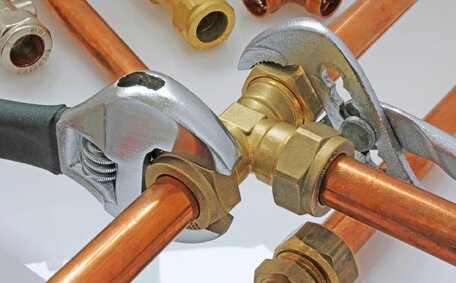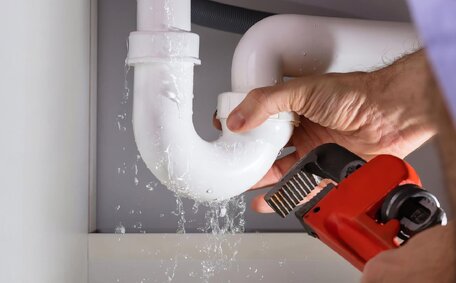Introduction - Why the need for emergency gas shutoff knowledge?
Knowing how to safely perform an emergency gas shutoff is a critical skill for all homeowners. Gas leaks or ruptured gas lines can significantly damage your home, particularly during natural disasters such as earthquakes, floods, or storms. Being able to swiftly find and shut off your gas line could prevent potential fires, explosions, carbon monoxide poisoning, or other hazardous conditions.
As licenced emergency plumbers and gas fitters based in St Ives, Sydney, the team at St Ives Plumbing has extensive experience dealing with gas your emergency and plumbing issues.
Available 24/7, we provide assistance with emergency gas shut-offs, water issues, gas leak detection, and repair of gas installations in the St Ives area. Our fully licenced and insured technicians will work on your gas system, ensuring its safe use by performing a thorough shut-off and inspection before restoring your hot water and other gas appliances.
In this article, we’ll walk you through the vital steps to turn off gas in an emergency, ensuring you’re prepared if the situation arises at your St Ives home or property.
Locating Your Gas Meter
It’s imperative to know where your gas meter is located outside your home, especially in an emergency gas shutoff situation. The off main valve of the gas meter box is normally located on the exterior of your St Ives home, either at the front, side or back. It may be mounted on the wall or freestanding on a concrete pad. Gas metres are usually grey-coloured boxes around 60cm tall with pipes and valves attached.
It’s essential to familiarise yourself with your property’s perimeter to locate your gas meter.
Mark its location to ensure it’s readily accessible during an emergency. A wrench to open the cover is typically the valve required for such tasks. Having a flashlight ready is a safe do that can assist in finding your way in low light conditions.
If you live in a unit complex, you can usually find the gas meter located in a shared space or external stairwell. Reach out to your strata or building manager or your gas company for specifics on accessing your building’s shutoff valves. For commercial buildings, hydrant boxes and switch rooms often house gas shutoff valves and the water system controls; for further details, leave your email address with building management.
Identifying Valves & Switches at the Meter
Upon locating your gas meter, you’ll find various valves, dials, pipes, and switches attached to your gas appliances. The most crucial component is the safety shutoff valve, which helps control the gas appliances pilot lights. This allows you to manually shut down the gas supply into your property.
The emergency LP gas shutoff valve, usually a prominent valve near the inlet pipe, controls the flow to your home. It likely has a square handle or wheel that shuts off or rotates 90 degrees into an ‘off’ position marked closed or with an ‘X’. Make sure not to turn any other valves at the metre.
You may also see a safety shutoff switch nearby, which is typically red in colour. Flipping this switch down will automatically stop flow gas by triggering an electrical solenoid valve that shuts it off. It’s wise to make sure your switch is tested annually by flipping it off then on to ensure it’s still operational.
Being familiar with the location of these emergency shutoff controls at your gas metre is vital preparation for a potential gas leak or fire emergency. Our team at St Ives Plumbing can also help inspect and ensure gas safety by identifying the various gas shutoff valves connected to your appliances around your St Ives property.
Signs of a Potential Gas Leak
Being alert to the signs of a potential gas leak is critical for safety. There are several key indicators to be aware of:
- A strong rotten egg odour due to mercaptan, an additive in natural gas and LPG to aid leak detection.
- Hissing, whistling or roaring sounds coming from gas pipe connections or gas appliances.
- Dirt blowing from a hole in the ground.
- Bubbles emerging in wet areas like water pipes, drains, ponds or creeks.
- Flames if the leak from natural gas lpg has ignited.
- Browning vegetation in one concentrated area.
If you notice these signs, it’s a strong indication that gas been leaked somewhere in the vicinity. When liquid propane or gas is lighter than air, leaks tend to accumulate in high areas to begin with. However the flow gas can spread rapidly, along floors and sinks etc.
If you still smell gas after inspection, when gas is potentially leaking, do NOT turn any electrical switches on or off, smoke, use a naked flame or operate anything that may cause a spark. Leave the area immediately and contact the emergency number, 000, once in a safe place to report the situation.
Steps to Safely Shut Off Gas Flow
In the event of a gas leak or if you need to switch off gas, call the hotline at 1800 427 and adhere to the following steps:
- Stay composed and move quickly. Immediately guide your family and others away from the affected area.
- Where safe, open all doors and turn off your gas meters and electrical switches to aid property ventilation.
- Avoid doing anything that could ignite the gas leak - do not smoke, turn electrical switches or appliances on or off, use phones or flashlights, or strike a match.
- Once at a safe distance, call 000 to alert emergency services.
- After emergency services have been notified, turn off meter gas using your gas metre’s emergency shutoff valve.
- Before turning off the gas with an adjustable wrench, wear enclosed shoes and gloves if available for protection.
- Use an adjustable pipe or crescent wrench to turn the off valve clockwise by 90 degrees to the 'off’ position marked with an 'X’.
- If an emergency shutoff switch is also present, flip this downward to the ‘off’ position as well.
- Enlist a licensed gas fitter to inspect your natural gas appliances prior to re-establishing gas flow.
Shutting off all gas flow promptly in an emergency can prevent carbon monoxide exposure, fires and explosions. Our team at St Ives Plumbing is always at the ready in the event emergency gas shutoffs or leak detections are needed.
When Not to Attempt Gas Shutoff & Call Professionals
Although understanding how to shut off your gas supply is essential, always contact a licensed professional in high-risk situations instead of attempting it yourself:
- If you detect a strong odour similar to portable gas or hear loud hissing noises, evacuate at once and call 000 for emergency services. Do not try to locate the shutoff valve yourself.
- If the gas leak or emergency is inside your home or involves internal gas pipes or appliances, do not attempt to find or access any indoor shutoff valves. Leave the area and call 000.
- If your shutoff valve or gas metre shows signs of damage, stop and call a professional as it’s safe to do so.
- If you are uncertain of the proper procedure or feel unsafe/uneasy about performing the gas shutoff, err on the side of caution and contact our team at St Ives Plumbing on 1300 349 338.
Our plumbers, fully licensed, vetted by police checks, and insured, are comprehensively trained to manage emergency shut-offs and repairs of gas leaks at home. We are available 24/7 to respond rapidly to any gas emergency in the St Ives area, ensuring it is handled properly and safely.
Contact our emergency plumbers for guidance on safely shutting off gas flow, or visit our website for more information. We can talk you through the process or despatch a technician urgently if needed. Safety should always come first when dealing with gas systems.
What to Do After a Successful Shutoff
After you have successfully shut off the gas supply to your St Ives property, there are still some important safety steps to take:
- Keep air flowing and prevent gas build-up by opening windows and doors to ensure ventilation.
- Do not turn on any light switches or use anything that may cause a spark.
- Contact your gas supplier like Origin Energy or your distributor like Jemena to report the off gas supply situation.
- Do not attempt to turn the gas back on by yourself; wait for a licensed gas fitter. Wait for qualified St Ives Plumbing technicians or your gas distributor to assess the safety of your gas system before restoring supply.
Trust only licensed professionals, such as our St Ives Plumbing team, to repair or reactivate gas water heaters following a thorough safety inspection. If in doubt, keep the gas turned off and continue ventilating the area until a gas fitter confirms it is safe to use gas in your system.
For after-hours assistance with emergency turning gas shutoffs, repairs or to safely restore your gas supply, get in touch with a licensed gasfitter from our 24/7 St Ives Plumbing team on 1300 349 338. Our expert technicians can execute gas-related procedures, ensuring all precautions are taken when restoring gas flow after a shutoff.






